 Leading Blog | Posts by Month |
 Leading Blog | Posts by Month |
08.31.17

LeadershipNow 140: August 2017 Compilation
See more on
Posted by Michael McKinney at 10:55 AM
08.28.17

The Mood Elevator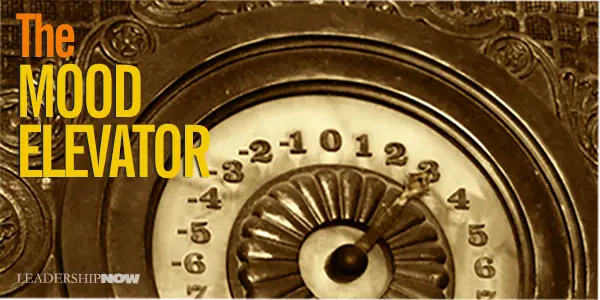
W But once we accept the fact that moods aren’t something that happens to us, but are the result of our thinking, we can do something to control them—or at least manage them better. Senn Delaney, Chairman and founder of Senn Delaney, wrote The Mood Elevator to help us take charge of our emotions and control our rides on the Mood Elevator. Step one is understanding that the way we respond to outside events depends on what is happening inside our heads. “There may be events that stimulate our thoughts, but it is the thoughts that determine our moods.” Reality is reality; it’s what we make of it that makes a difference in our lives. You will never let go of your moods completely, but knowing that your thoughts are the source of those moods can provide a little added distance and help you remain in control. It’s a powerful first step to learning to ride up the Mood Elevator rather than feeling like a helpless victim of emotional forces you can’t control. Why Does It Matter? When we are down the Mood Elevator our thinking is closed. When we travel up the Mood Elevator our thinking improves and opens up. We can reconnect with our best self. We all come into this world with the potential for mental and emotional health. Our natural state is to be loving, creative, trusting, forgiving, curious, happy, and desirous of warm, close relationships with others. Unfortunately, as we grow up most of us develop thought habits or beliefs that can mask or obscure our innate health. At some point, we are hurt by someone, and we may become guarded and defensive. We are criticized for a mistake, and we may learn to make excuses and blame others, seeking to become less accountable so we don’t look bad.
Unfortunately, we can become stuck so long on the lower floors of the Mood Elevator that we can begin to think that it’s normal. Recognize when you are staying on the lower-floor emotions. Although it doesn’t make us happy, we can actually grow comfortable with self-destructive patterns of thought, negative thinking, and victimization. So we feed these thinking patterns and reinforce them with stories told to validate our perspective on life. Other people are often motivated by the same things we are. It’s just that their perspective is different than ours. It’s best for us if we let it go. How to Move Up the Mood Elevator The dividing line is curiosity because when something happens that threatens to pull you down to the lower floors, you can stop yourself and ask, “I wonder why they did that? It would be interesting to find out.” We tend to rush to the judgmental/blaming floor but with a curious perspective, you can begin to move up to the higher floors. Learn to interrupt your own mood patterns and typical responses. A good night’s sleep, exercise, deep breathing, positive self-talk, and even listen to your favorite music can all help in this regard. Adapt an attitude of mild preference. Senn explains: Living in mild preference doesn’t mean adopting a Pollyanna attitude. It does mean looking for positive steps you can take to solve problems when they arise—and refusing to wallow in the emotions of frustration and anger that problems can so easily generate. Living in mild preference does not mean having no standards or principles. It does mean being selective about how and when to apply your standards and principles—choosing your battels carefully, as the saying goes. Naturally a sense of humor and humility help here. But at the top of the Mood Elevator, you will find gratefulness. Senn calls it the overriding emotion. “It’s almost impossible to be grateful and at the same time be angry, depressed, irritated, or self-righteous.” Gratitude is a good way to maintain a healthy perspective on what’s happening in your life. “Focus on activities that will nourish your sense of gratitude and your appreciation for the blessings you’ve already been granted.”. A few other important thoughts to help us manage our moods: Recognize and honor separate realties we all live in. Be quick to understand other’s perspectives and slow to blame or criticize. 
Posted by Michael McKinney at 07:30 PM
08.18.17

4 Things Solitude Will Do for You
W I know none of us have any extra time, but there is overwhelming evidence that taking a time-out to simply think is foundational to your success. Raymond Kethledge and Michael Erwin explore some solid reasons why you must make the time to think in Lead Yourself First. When we say solitude we mean a “subjective state of mind, in which the mind, isolated from input from other minds, works through a problem on its own.” There is no particular structure to it—place, time, or length—but it must focus the mind. It’s scheduled white space—a commitment you make to yourself simply because your leadership begins with who you are—not what you do. So let’s look at four things solitude will do for you. Clarity Clarity is about what is true. What is signal and what is noise? Solitude facilitates that distillation process. It helps you to eliminate or deliberately deemphasize all distractions. That alone will help you to make the time to think. Clarity and focus go hand-in-hand. That kind of focused attention is often best done alone. Intuition complements analytical thought. When we get stuck, “intuition can provide clarity when analytical thinking cannot.” The challenge is accessing it. Accessing intuition requires “a deeper form of solitude: an absence of inputs not only from other minds, but also from one’s own.” Clarity is important for decision-making but it is also critical for understanding who you are—strengths and weaknesses. It helps to connect you with your core values and understand your place from that perspective. Creativity Solitude opens the path to creativity. Solitude isn’t always the shortest distance to the goal. Joey Reiman, CEO of the consulting firm BrightHouse, credits their success to their “longer, incubation pace.” On one project he says, “If we had moved at a faster, business pace, we never would have excavated that original brand identity and then generalized it into a new ethos.” Dena Braeger, mother of six in El Paso, offered this insight into information overload: People make such an effort to copy what other people do, because we have so much access to information. I’m surrounded by people on Pinterest. I’ll be dammed if I make something on Pinterest. You’ll see things like these cupcakes that look amazing. And people copy them. But on the inside their phony, because the person didn’t create it themselves. We’re getting more of everything, but less of what is authentically ourselves. If we spent more time alone, creating something that might not look as amazing but is more authentic, we’d value ourselves more. Creativity is doing something differently than the norm. Solitude allows us to get away from the inertia of our environment and connect to new possibilities. Emotional Balance Emotional balance requires you to respond rather than react. General James Mattis finds a lack of reflection the single biggest problem facing leaders. “The leader who neglects to step out of the sweep of events, to contemplate from whence they come and where they might go. Finds himself merely blown from one thing to another. But the leader who steps outside events is a leader who can change them.” Solitude allows you to reflect on what is making you emotional and provide clarity on the issue. Often what you are emotional about is more of a distraction than an issue. Again Dena Braeger, the West Point graduate and mother of six in El Paso, said, “When I’m practicing solitude regularly, I self-correct so much better. I’m more focused on what’s important, and I let things go that aren’t important.” Instead of allowing our emotions to adversely affect our leadership, it is wise to move away and deal with them in private. Our emotions will find an outlet somewhere. And that is best alone than in decisions made through unfiltered emotions that affect those around us. Moral Courage We’ve all seen them: leaders who take themselves too seriously—who believe their own press release. And it’s all too easy for any of us to fall prey to self-admiration. “Honest reflation can deflate these pretentions.” Reflection can pave the way to humility. Solitude allows you to slow down and be clear and firmly convicted of your values and beliefs. “Leaders who are well anchored in what they believe are going to be more effective,” says Doug Conant, the former CEO and president of the Campbell Soup Company. When those criticisms come along that are design to enforce conformity, it is easier to weather the storm when you know that what you are doing is the right thing to do for the right reasons. It is the power to rise above. Reclaiming Solitude Brené Brown, author of Daring Greatly, says that “The biggest mistake I’ve made in my career to date is believing that solitude is a luxury. I could chart the ups and downs of my quality of life personally and professionally and the amount of time I spend in solitude.” As important as it is, it is easy to let it slip away without even realizing it. We are continuously bombarded by pressures—both personal and social—not to stop and reflect but if we lose our solitude, we will lose who we are. You don’t have to go off to a mountaintop or sit at the seashore. It can be a closed room, the library, a park bench, and even a waiting room. We have a responsibility to seek out periods of solitude. We owe it to ourselves and those we lead. Of Related Interest:

Posted by Michael McKinney at 04:05 PM
08.16.17

5 Ways You Can Improve Your Relationships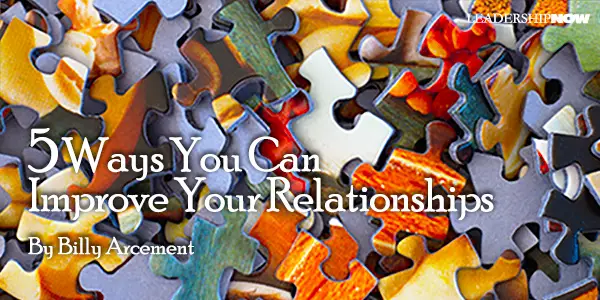
K

Posted by Michael McKinney at 08:14 AM
08.14.17

How to Harness the Power of Your Intuition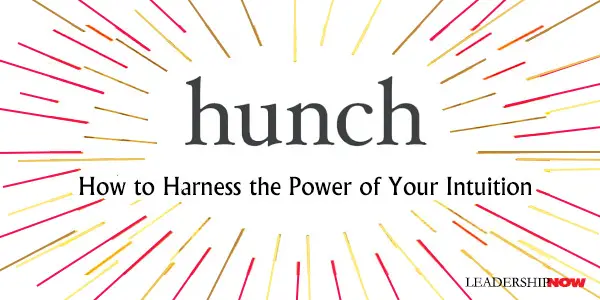
T Hunch by Bernadette Jiwa, is an invitation to pay attention to your hunches, reawaken skills you’ve neglected or forgotten, and develop new capabilities you need. Hard data has its place, but it only describes a part of reality. “The more we defer to hard data alone to shine a light on the truth, the more we neglect opportunities to nurture inherent curiosity, develop emotional intelligence and cultivate imagination.” We are in danger of becoming a generation of plugged-in, look-it-uppers who are more ready to take things at face value and less willing to inquire or explore. More satisfied with proof and less open to discovery. More inclined to consume rather than create. More fearful of uncertainty than open to possibility. There is a tension to be managed here. The tension between certainty and uncertainty. From our uncertainty, we need to learn to ask the right questions. Our answers are no better than our questions. Groundbreaking ideas are only groundbreaking because they solve a problem. An idea in search of a problem is irrelevant.  A hunch, says Jiwa, “is a combination of insight and foresight, brought about by understanding what is and questioning what could be.” It is informed by “our expertise, past experiences, and the practice of noticing patterns and anomalies in the world around us.” A hunch happens at the intersection of Curiosity, Empathy, and Imagination.
Interest + Attention: Learn to see problems and discern which ones are worth solving. Curiosity stems from caring to know what you don’t know. Hunger for the novel. We have never had the opportunity to look for more answers and yet we have forgotten the importance of stopping to question. Spend 15 minutes to sit and observe. Records what you see. Notice frustrations. What’s wrong, and how could it be fixed? Empathy
Imagination
We are shaped and influenced by our environments, and that is our choice. What is shaping you? “Moments of insight are shaped by the experiences that lead up to them, and we cannot ever know the true impact of the thousands of experiences and encounters that made each of us who we are—or how they influence the judgments we will go on to make.” Genius is where you look for it. Begin. 
Posted by Michael McKinney at 08:24 AM
08.11.17

Leadership Lessons from a 19th Century Genius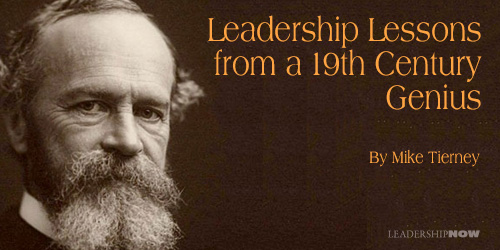
W “A great many people think they are thinking when they are merely rearranging their prejudices.” Much of the time we should spend listening is spent preparing a response instead. As we progress through our careers, keeping a truly open mind becomes increasingly difficult. Real problem solving comes when we allow the experience of others room to inform our thinking. I know that my own obstinacy has sometimes prevented me from seeing a better way forward. Some years ago, I was presented with the opportunity to hire an exceptionally talented individual. There was no open position that aligned with the individual. But make no mistake, this was a true talent and a good person. Rather than crafting a role that made sense, I tried to force a fit. At the time it seemed like the right approach – we had an opening that this person could fill, and over time we could have expanded the role. Instead, I let short-term tactical thinking cloud my execution. I have also found that remembering your own frustration when others are not open to your input helps you put aside your own prejudged ideas aside to allow others to contribute. “When you [decide] to make a choice and don’t make it, that is in itself a choice.” Some may be more familiar with the more recent formulation of Rush’s Neil Peart: “If you choose not to decide you still have made a choice.” The point is that putting off decisions, no matter how big or small, has impact. This is not to suggest that all decisions should be made on the spot without properly assessing data and input. But too often the trap of always seeking more, or letting the quixotic quest for perfection prevent the implementation of the good, turns a “no” decision into the decision. Rarely is the no decision the right decision. I can think of a time when I allowed myself to delay making a decision that I knew needed to be made. I had done the needed analysis and knew what the right call was, but because it was an exceptionally tough – and impactful – call to make I put it off longer than I should have. I needed to make a staffing change that would significantly shift responsibilities away from one person. This was someone who had made a positive impact but who had, over time, become less effective in his role. The change would be difficult for him personally and financially, and carried with it some risk of fallout in other areas of the organization. Ultimately the call got made and proved to be the right one, but the delay had a cost. “Act as if what you do makes a difference. It does.” I think most people wrestle with the question of whether what they are doing is truly meaningful. Call it the legacy question. I have been blessed with the ability to provide for my family, and am proud of the hard work I have done in my career. But I am most proud of the times I have been able to assist someone else in their development – both professionally and at times personally. I’m particularly proud of the success of one person whom I “inherited” when I took over an established team some years ago. It became clear to me that he was not realizing his full potential – mainly because he had not received enough guidance or support in order to be successful. He was very responsive to being challenged, to see beyond the tactical aspects of his role and embrace a more strategic one. As a result, he transitioned from being a capable contributor to a leader. He needed strong backing initially to help counter some very strong personalities who carried more senior titles. But he prevailed. “Nothing is so fatiguing as the eternal hanging on of an uncompleted task.” As the demands on our time increase, the temptation to multi-task grows. One of the basic tenets of product management is that it is better to solve one problem completely than address multiple ones partially. This holds true beyond the realm of the product manager. Multi-tasking sounds positive. It conveys business, which is often equated to importance, and suggests competence. Time slicing does not sound nearly so positive. It communicates that only a fraction of our time and attention is being devoted to a task. Multi-tasking and time slicing are, in fact, one and the same. There are so many approaches to task prioritization. Find the one that works best for you. Resisting multi-tasking is an everyday challenge. Don’t give in. This is a lesson I need to relearn whenever I catch myself giving in to the temptation to time slice. “The art of being wise is the art of knowing what to overlook.” Not everything requires your attention. There are decisions we must make and problems we must address. But teams exist to share that workload. Trust your teams to execute. One of the most self-aware people I have worked with builds teams with people who are strong in areas he is not. One of the benefits of this approach is that he knows he can rely on his team to address challenges and attack opportunities that he cannot. An honest accounting of our own strengths and weaknesses is a difficult, but beneficial task. Getting input from others we trust can be of great value. Knowing what to overlook also means knowing what not to overlook. I have learned that the number one thing not to overlook is attitude. The presence of a negative attitude has persistent harmful effects. Understanding and addressing the causes of a poor attitude can work wonders to overcome this. But there are times when negativity outweighs whatever contributions a person makes—and he has to be removed in order to preserve the organization. 
Posted by Michael McKinney at 05:14 AM
08.09.17

What Kind of Innovator Are You?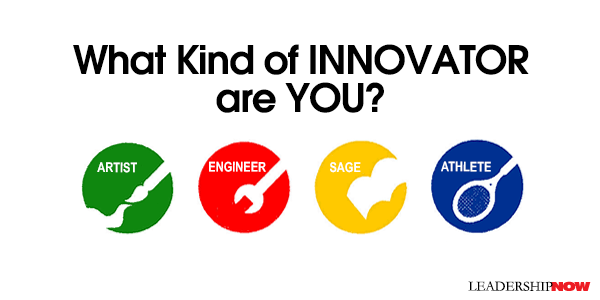
I When it comes to innovation, it is no different. Jeff DeGraff writes in The Innovation Code, “Your dominant worldview is your biggest strength—the quality that makes you stand out from other people.” He adds, “On the other hand, your dominant worldview is holding you back. Your defining quality is also your greatest weakness. The problem is that our dominant worldviews overpower all other points of view.” And it distorts reality as we miss the bigger picture. So the place we want to come to is knowing what gift or perspective we bring to the table and then learn to combine it with the gifts of others to create a positive tension that promotes sustainable and scalable growth. First, we need to get to know ourselves. DeGraff describes four basic worldviews or approaches to innovation: the Artist, the Engineer, the Athlete, and the Sage. The Artist The Engineer The Athlete The Sage DeGraff provides each type with more in depth characteristics and examples. He lays out the strengths and weaknesses of each and what do about it, including how to work with each of the other types. What kind of innovator are you? DeGraff has created an online assessment. Here’s the thing. When you bring these four types together it can get messy. But it can be constructive. “The key,” says DeGraff, “is not to strike a balance but to know when you need more or less of each approach.” If we know the strengths and weaknesses of our type, then we can know what types we need to surround ourselves with to complete the picture and to find an approach that will work. Knowing the kinds of innovators you need to bring to a project is all about knowing all of those things you can’t do (well) yourself. Not surprisingly, different stages of organizational growth require more of one type over another. “At their onset, groups need more Artists and Athletes. Artists will give a young company a creative edge, while Athletes come up with a playbook. As it starts to grow, the organization has to get the right people and community involved and develop the best customer relationships. This is when the company needs Sages. Finally, when the organization gets really big, it needs structure, processes, and hierarchy—the gifts of Engineers.” When it matures, the organization needs to reinvent itself. “Instead of maintaining the same ratio of different kinds of thinkers, the organization needs to incorporate more Artists or Athletes or Sages or Engineers, whichever form will add more variance to the current situation.” 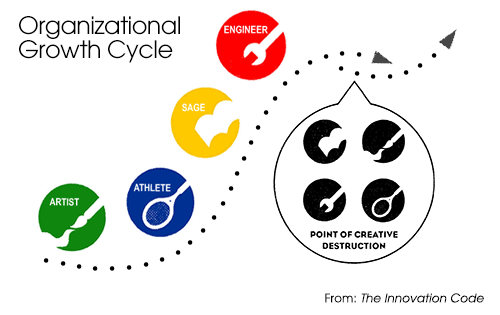 “When you combine the radical, visionary thinking of the Artist and the methodical, practical thinking of the Engineer, you get innovation that’s both revolutionary and manageable, highly ambitious but without high risk. When you combine the cutthroat, results-oriented attitude of the Athlete with the conscientious, values-oriented attitude of the Sage, you get innovation that’s both a good investment and good for the world.” 
Posted by Michael McKinney at 12:18 AM
08.07.17

Employees Do Care – and How that Helps your Bottom Line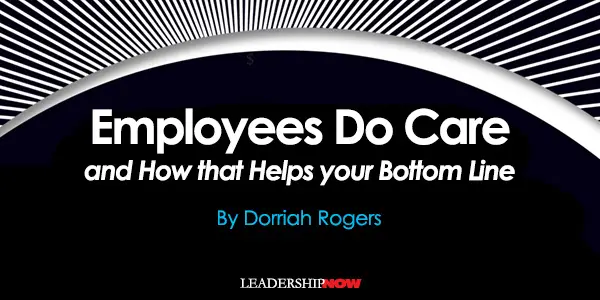
O 1. Create a behavioral culture of continuous improvement Managers and executives must promote a culture of continuous “improvement” as opposed to a culture of continuous “growth.” And there is a reason for that distinction. In my experience, many companies view “growth” as increased top-line revenue or sales, additional product lines, or entry into new markets, for example. Growth is typically more of a step event, as opposed to improvement, which is embedded and incremental. In my opinion, none of these are the true indicators of success. Success is only possible when you can do all of these things AND increase profit. In order to develop a culture of continuous improvement there are two primary areas of focus: behavioral changes and a clear system to enable ideas for change. What happens within organizations as they push for change and growth? For one, behaviors change. Where once a handful of individuals made key decisions, these decisions are now spread across numerous departments and individuals at all levels of the organization. Agility and flexibility are replaced by process and a mind-numbing disconnect from business goals. Innovation and creativity are supplanted by overhead creep, loss of productivity, and poor business decisions. Managers and executives need to own these impacts and make some changes. To make this happen I recommend the following:
2. Provide a process for employee-owned, sound and innovative business decisions that are tied to sustainable growth and profit. Decide to Profit: 9 Steps to a Better Bottom Line was written specifically in order to provide a step-by-step guide that aligns both employees and managers around connecting all ideas and decisions that affect change to the financial goals of your company. Employees have a clear system that links decisions to the financial performance of their organization. Managers have a ready tool to shape their organizational culture and business outcomes. With this system, both leaders and employees can adapt and change through external transformations in the marketplace and increasingly tough competition, and ultimately, maintain net profit. The 9 Steps enable both employees and managers to avoid common decision-making mistakes and taps directly into the fact that your employees DO care about your bottom line. The book also provides checklists and tools to foster a creative and idea-driven culture within your organization, and, ultimately, easy to understand and implement guidelines to ensure a financially sound future. The chapters outline each of the steps, its application, checklists, critical questions to ask, and easy-to-use forms for managers and employees. Embedded within each step are checks and balances and a process for accountability so that managers and employees can remain in sync in both their thinking and actions. In order for the 9 Steps to work effectively, the culture of the organization implementing them must reflect an ongoing and continuous curiosity, which ties directly back to the first recommendation. Culture and process are inextricably linked. Complacency and surrender can kill this curiosity, and creating this type of culture can be extremely difficult especially if historically your people and processes are embedded. Within the 9 Steps (Steps 1-8), a process is imbedded that allows alignment between employees and management that is focused on the right decisions for the right reasons: to ultimately make money. Step 9 is designed to ensure that your people and your ways of thinking are always asking questions, always challenging yourselves, never accepting the as-is, and ensuring that whether you fail or succeed at change or innovation does not quell the desire to constantly come up with new and better solutions. And Step 9 has a built-in feedback loop that continuously brings you back to Step 1 and so on. So between cultural behaviors and a straightforward internal process that ties directly to the financial success of your organization, leaders can provide both the tools and inspiration for success.  
Posted by Michael McKinney at 09:24 AM
08.03.17

How to Work with People You Don’t Agree with or Like or Trust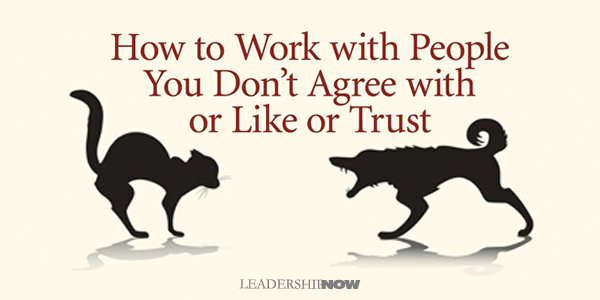
I Faced with our country’s overwhelming problems, we have two options: a practical option and a miraculous option. The practical option is for all of us to get down on our knees and pray for a band of angels to come down from heaven and solve our problems for us. The miraculous option is that we work things through together. If we (and they) choose to collaborate, how do you work with people you don’t trust, who have incompatible agendas, and histories of dislike? What do you do when you need to come together to solve a problem but they can’t see it your way? Part of the issue is we come into the collaboration with the idea that we can control the process; we can get people to make the changes we need them to make. When a situation with others becomes hopeless or dire, we double-down and try to find a way to convince them, even force them to change in order to bring them into alignment with our thinking. Underlying this approach is the belief that I/we know what is best and it is my duty to make them change for their own good. When faced with others different from us we tend to label them as enemies. We demonize and vilify them. Call them names even. Our enemfying, which feels exciting and satisfying, even righteous and heroic, usually obscures rather than clarifies he reality of the challenges we face. It amplifies conflicts; it narrows the space for problem solving and creativity; and it distracts us, with unrealizable dreams of decisive victory, from the real work we need to do. We need a better approach and mindset. Kahane introduces an idea called stretch collaboration. We need to shift our thinking in three ways: The first shift is instead of focusing on a narrow focus over the good and harmony of the team, we should embrace the conflict and connection within and beyond the team. In short, we have to affirm the legitimacy of every perspective of the group. Each participant brings a perspective that they care about and by acknowledging all we can form a more complete picture. The second shift deals with the process. Instead of insisting on one right view of the problem, the solution, and the plan, we need to move toward experimenting systematically with different perspectives and possibilities. We learn together. We think through the issues and solutions together to see what could work. The idea is to cocreate new options as we—together—work through the issues. The final shift requires us to see ourselves as part of the whole and as one orchestrating the collaboration. We are a participant as much as everyone else. We tend to overlook ourselves as part of the problem. Bill Tobert once told Kahane that “if you’re not part of the problem, then you cannot be part of the solution.” Ego is always an issue. “When we are faced with a challenging situation, we focus our attention first and foremost on what other people are doing or not doing or out to be doing.” Kahane adds, “Blaming others is a common and lazy way to avoid doing our own work.” These shifts require us to move outside ourselves. “Self-centeredness means that we arrogantly overestimate the correctness and value of our own perspectives and actions, and we underestimate those of others.” Keep in mind, “Your enemies can be your greatest teachers.” 
Posted by Michael McKinney at 12:57 PM
08.01.17

First Look: Leadership Books for August 2017Here's a look at some of the best leadership books to be released in August.    
For bulk orders call 1-800-423-8273  Build your leadership library with these specials on over 39 titles. All titles are at least 40% off the list price and are available only in limited quantities. "A room without books is like a body without a soul." — Marcus Tullius Cicero
Posted by Michael McKinney at 08:27 AM
|
BUILD YOUR KNOWLEDGE


How to Do Your Start-Up Right STRAIGHT TALK FOR START-UPS 
Grow Your Leadership Skills NEW AND UPCOMING LEADERSHIP BOOKS 
Leadership Minute BITE-SIZE CONCEPTS YOU CAN CHEW ON 
Classic Leadership Books BOOKS TO READ BEFORE YOU LEAD |
|